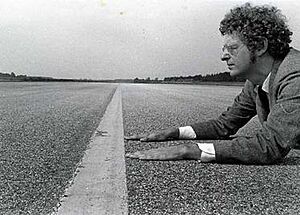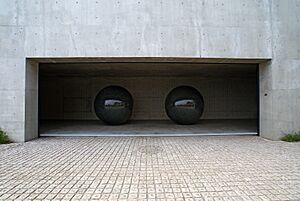Walter De Maria facts for kids
Quick facts for kids
Walter De Maria
|
|
|---|---|

De Maria in 1968
|
|
| Born | October 1, 1935 Albany, California, US
|
| Died | July 25, 2013 (aged 77) Los Angeles, California, US
|
| Known for | Installation art, sculpture |
| Movement | Minimalist, Land art |
Walter Joseph De Maria (October 1, 1935 – July 25, 2013) was an American artist. He was known for his sculptures and large-scale art projects. He lived and worked in New York City. Walter De Maria's art style is linked to minimal art, conceptual art, and land art from the 1960s.
Michael Govan, who leads the LACMA, called De Maria "one of the greatest artists of our time." He described De Maria's work as "unique, amazing, and direct."
Contents
Walter De Maria's Early Life and Art Journey
Walter De Maria was born in 1935 in Albany, California. His parents owned a restaurant and were very active in their community. Walter, however, focused mostly on music. He first learned piano, then percussion (drums). He also enjoyed sports and drawing cars. By 1946, he had joined a musicians' group.
De Maria studied history and art at the University of California, Berkeley from 1953 to 1959. He first trained as a painter, but soon started making sculptures. In 1960, De Maria and his friends, who were avant-garde composers, took part in "happenings." These were art events that combined different forms of art.
He also created interactive sculptures. For example, his Boxes for Meaningless Work (1961) had instructions. They told people to "Transfer things from one box to the next box back and forth, back and forth, etc. Be aware that what you are doing is meaningless." This made viewers think about the purpose of their actions.
In 1960, De Maria moved to New York City. He married Susanne Wilson there one year later.
Developing His Unique Art Style
His early sculptures in the 1960s were inspired by art movements like Dada, suprematism, and constructivism. This led him to use simple geometric shapes. He also used industrial materials like stainless steel and aluminium. These materials are also common in Minimal art. With help from art collector Robert C. Scull, De Maria began making metal artworks in 1965.
In the mid-1960s, he became involved in many art activities. His piece, Cage, was shown in an important exhibit called Primary Structures in 1966. He also composed two musical works and made two films in 1969.
De Maria briefly ran an art gallery in New York City with his wife. They showed rare films and exhibited his early Minimalist sculptures made of wood.
In 1965, De Maria became the drummer for a rock band called the Primitives. This band included Lou Reed and John Cale, who later formed The Velvet Underground.
De Maria passed away in Los Angeles on July 25, 2013, at 77 years old.
Exploring Land Art and Installations
Starting in 1968, De Maria created Minimalist sculptures and large installations. One example is the Munich Erdraum from 1968. He also made Land art projects in the deserts of the southwestern US. His goal was to create experiences where nature, light, and weather became a strong, physical, and emotional part of the art. De Maria wanted his art to make people think about Earth and its place in the universe.
The Lightning Field (1977) is De Maria's most famous artwork. It has 400 stainless steel posts arranged in a precise grid. This grid covers an area of 1 mile by 1 kilometer. The way the light changes throughout the day and the weather affects how the art looks. It also lights up during thunder storms. The Dia Art Foundation takes care of this artwork.
De Maria also created lasting artworks in cities. Vertical Earth Kilometer (1977) and The Broken Kilometer (1979) explore the idea of hidden or imagined distances. Vertical Earth Kilometer is a one-kilometer-long brass rod. It is drilled into Friedrichsplatz Park in Kassel, Germany. Only the top of the rod, which is flush with the ground, can be seen. It is surrounded by a red sandstone plate. In 1979, De Maria carefully arranged 500 brass rods for The Broken Kilometer. This is a permanent artwork in New York.
Different from the hard metal of the Kilometer pieces, The New York Earth Room (1977) is a room filled with earth. It is 3,600 square feet and filled 22 inches deep with 250 cubic yards of soil. This New York artwork is a permanent version of a temporary installation he made in Munich in 1968.
De Maria also created other large sculptures using a horizontal design. These include Apollo's Ecstasy (1990) and The 2000 Sculpture (1992).
In 1989, De Maria finished a polished granite sphere for the Assemblée Nationale in Paris. Later, he created works for two museums on Naoshima Island in Japan. These were the Naoshima Contemporary Art Museum and the Chichu Art Museum. A similar 25-ton sculpture called Large Red Sphere (2002) was placed in the Türkentor in Munich in 2010.
One Sun/34 Moons (2002) opened in 2007 at the Nelson-Atkins Museum of Art in Kansas City. In 2010, The 2000 Sculpture (1992) was the first artwork to be shown at the Resnick Pavilion at the Los Angeles County Museum of Art.
Where Walter De Maria's Art Was Shown
De Maria and Robert Whitman opened the 9 Great Jones Street gallery in New York in 1963. That same year, De Maria had his first solo show of sculptures there. His first solo exhibition in a commercial gallery was in 1965.
De Maria often avoided showing his work in museums. He preferred to create his installations outdoors or in unusual places in cities. His art was shown more widely outside the United States, with major exhibitions in Japan and Europe.
He took part in Documenta in Kassel in 1968 and 1977. There, he installed his permanent public sculpture Vertical Earth Kilometer. In 1972, a major exhibition of his sculptures was held at the Kunstmuseum Basel. He also had many solo exhibitions. These were organized by places like the Centre Georges Pompidou in Paris (1981) and the Chichu Art Museum in Naoshima (2000 and 2004). "Walter De Maria: Trilogies" was his first major museum exhibition in the United States in 2011.
Films About Walter De Maria
In 2015, filmmaker James Crump made a documentary called Troublemakers: The Story of Land Art. This film shows rare footage of De Maria and his artworks. It focuses on the desolate desert areas of the American southwest. Troublemakers was chosen for the 53rd New York Film Festival in 2015. The film was released in theaters in New York in January 2016.


